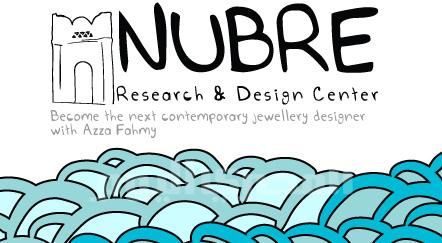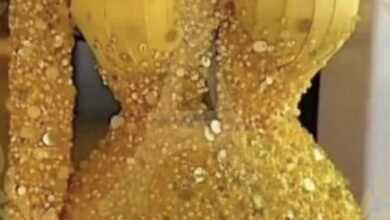
It’s always inspiring to see the fruit of creative labor on display, especially when the products have been created in a supportive, artistic environment and the talent is young, fresh and ambitious.
On 8 May, a jewelry design exhibition launched at the British Council in Agouza, showcasing the creative fruits of the participants of Nubre, a series of workshops by the first Egyptian private sector initiative to support local design talent.
Titled ‘The Power of Contemporary Design’, the exhibition is a collaborative effort between celebrated Egyptian jewelry designer Azza Fahmy and the European Union. Held on the first floor of the British Council, the four-day exhibition displays the creations of 45 Egyptian students who attended several months of workshops in the southern city of Aswan. Appropriately, the name ‘Nubre’ means design in the Nubian language; the influence of the Nubian landscape, people and heritage is reflected in many of the designs as well as the set design created by Moataz Nasreldin of Darb 1718.
The workshops were taught by international jewelry design and contemporary design experts, including award-winning jewelry designer Jean Power, designer Doris Maninger from Alchimia School in Florence and fine jewelry/ metalwork craftsman Christoph Zellweger from Switzerland.
“We chose Nubia for the location of the workshops because it’s breathtakingly beautiful,” Azza Fahmy said at the opening ceremony on Tuesday. “The area is also very isolated and neglected by the rest of Egypt; so we wanted to expose our students to this tremendous place in its natural environment, culture and history.”
Organizers said Nubre was launched to help create a design culture in Egypt and to bridge communication between local and European design students, which is why the displayed products at the exhibition included works by students from Spain and Italy, among others. The workshops focused on teaching the students how to find inspiration and how to work it into their designs.
Students were asked to incorporate natural materials from the Nubian environment into their creations, after which Fahmy and her team worked with the students on transforming their whimsical concepts into real, wearable pieces of jewelry.
The most talented designs are to be awarded financial prizes and recognition, and the best students will be offered an opportunity to work with the Azza Fahmy Foundation on future projects.
Crowds of spectators navigated through the packed exhibition room on Tuesday night, following a short performance by contemporary dancer Mounir Saeed in the garden. The display room’s walls carried touch screens displaying information on the Nubre workshop and the designers’ work, and the designers stood next to their work to explain their concepts to onlookers.
The exhibition’s set design was clearly inspired by the natural landscape and culture of Nubia: eight fishing boats were brought in from Aswan, cut and arranged tails up, their hulls used as display space for the items. While the rich colours of earth brown, blue and metal definitely emphasized the Nubian atmosphere, the display cases did not adequately display the jewelry.
For example, a thin wire attached to the matching gold and bean crown and necklace by Reham Mogawer did little to emphasize the pieces’ elegance, and the inadequate lighting and display at the bottom of the boat did not do justice to Caroline Shoushanian’s beautiful and delicate woven bangle, out of which blue and red beads hatched like fish caught in a net. This was by far one of the best pieces on display, so its positioning was disappointing.
Further on in the room, a long metallic table held up by wooden brooms displayed rings, brooches and necklaces, including a brooch of prettily painted cut glass, delicately circled by silver wire by Aisha Al Shabrawy, and Nesreen Konstanteen’s triangular-tipped ring with a blue bead embedded on one side and an ivory coloured stone on the other.
Eager spectators who picked up the items to try them on were told not to, which is unfortunate: when a jewelry piece is displayed openly and without ties to a surface, it’s an instinctive pleasure to try it on. Perhaps the items should have been attached to loose wires, allowing them to be touched and tried on without being taken away from the table.
At the end of the room, a large wall displayed a maze of thin wires carrying a whirlwind of beads and stones in different patterns, colours, textures and sizes. Behind the wires, more of the students’ necklaces, rings and earrings were on display.
The set design overwhelmed the products; instead of placing them at the forefront, they were overshadowed and obstructed by the overly busy display. The concept itself was great and seemed to be inspired by fishing nets, with the jewelry being the treasures found in the sea; yet its implementation didn’t do justice to the pieces.
Rehab Dessouki’s set of earrings, ring and necklace combined beads of blue, red and white with natural stones and a silver pendant of a Nubian house; but it was her ring that stood out the most: the outer silver shell of the ring was shaped into a simple house, while the inside was lined with tiny blue and white beads; a refreshing structure and fusion of materials.
On another wall, lines of multicoloured post-its work as an inspiration board, with words like ‘integrity’, ‘dignity’ and ‘purposefulness’ as well as the designers’ names. Below, several pieces were displayed, such as Lina Chawky’s political necklace, which combined rough rope, porcelain and pyramid shaped pendants with political slogans. The framework of the design itself was a little too familiar and the message was literally spelt out, leaving little to the imagination.
The trouble with a contemporary design exhibition is that the spectator is often torn between appreciating the pieces as works of art and contemplating their aesthetic and commercial appeal – the question ‘would I wear that?’ is inadvertently brought to mind, and when it comes to jewelry by aspiring designers, it’s quite a relevant question. Jewelry must be bought and worn, no matter how edgy or avant-garde it may be.
Several pieces on display had commercial appeal, while others had distinctive designs that would make them great contemporary signature pieces. While some items were underwhelming in creativity and design, the overall effort was highly commendable and it is truly inspiring to see such energy and dedication exerted into raw local talent.
The overall theme to the pieces was one heavily inspired by Nubia’s landscape – in the fusion of earth tones, sea colours, natural stones as well as natural materials such as fruit and nut shells, weathered wood and the shapes of houses, palm trees and the Nile. A few pieces stood out in terms of quality of concept and creativity, including Weronika Marek’s necklace of black shapes tied with thin blue thread, which was both wearable and exciting in its diverse, enigmatic shapes.
Eva Gerbes’s brooch was also a standout design in its simplicity and fusion of nature with design: one side of the brooch carries the pitted shell of a doum fruit, while the other carries two outlines of a spoon shape in thin silver. Gihan Shamashergy’s brooch of a woman’s head carrying the shapes of a felucca, a palm tree and the key of life in silver and gold was one of the most clean-cut and wearable pieces at the show.
While Fahmy’s legacy and influence can be spotted in several of the designs, there were enough inspired and unique creations to prove that her goal of broadening the designers’ visions and inspirations had been successful.
“We wanted to introduce them to influences that they may not have been exposed to before so that it wouldn’t be influenced by Azza Fahmy,’ she said. “That’s why we brought in so many experts from Europe to teach them how to think and be inspired without restrictions.”
Fahmy added that she was extremely proud of the outcome, and that many of the students had great potential to become leading jewelry designers in Egypt.
“Even better designers than Azza Fahmy,” she said, smiling.
The Nubre exhibition will be held at the British Council until May 12th, after which it will move to different locations in Cairo and Aswan. For further information, please contact www.nubre.com
[You can find photos of the jewelry here] http://www.klimt02.net/exhibitions/index.php?item_id=28165




